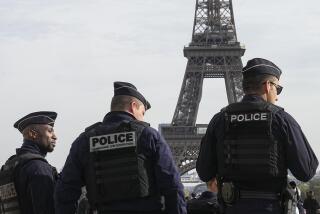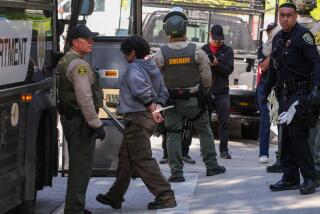Bush Sends Force at Request of Bradley, Wilson
- Share via
WASHINGTON — President Bush announced Friday night that he had ordered 4,500 federal troops into action in Los Angeles to help quell riots if violence flares anew.
At the same time, Bush said he had ordered 6,000 National Guard members to be put under federal control to create a “Joint Task Force Los Angeles” to reinforce overburdened state and local forces.
“I will use whatever force is necessary to restore order,” Bush pledged in a prime-time, nationally televised address. “What is going on in L.A. must and will stop. As your President, I guarantee you: This violence will end.”
White House officials said Bush had made the decision after speaking by telephone with Gov. Pete Wilson and Mayor Tom Bradley only moments before delivering the 10-minute speech. They said both Wilson and Bradley had requested the federal intervention.
In the address, Bush also announced that a federal grand jury had already issued subpoenas as part of the accelerated Justice Department investigation examining whether the beating of Rodney G. King violated U.S. civil rights statutes.
The unusual presidential disclosure was described by White House aides as an attempt by Bush to soothe the destructive anger sparked by the not-guilty verdicts returned in the case.
But despite what were intended as reassuring words, Bush left no doubt of his determination to maintain a rigid stance in the face of riots that have presented him with perhaps his most trying domestic crisis.
Bush said the commitment of the 4,500-strong Army-Marine joint task force would “help restore order” amid continuing “incidents of random terror and lawlessness.”
He had ordered the federal troops and 1,000 other federal agents, including FBI SWAT teams, U.S. marshals and special Border Patrol units, to Los Angeles earlier in the day. The agents were put into service immediately. A decision on whether to deploy the troops had not been expected until Saturday.
The Oval Office address was Bush’s first to the nation since the collapse of the Soviet Union late last year. Apart from a 1989 speech about the dangers of drugs, it was the first time he had chosen the portentous setting to dramatize his concern over a domestic issue.
In outlining his response to the violence about 48 hours after it began, Bush for the most part followed a pattern in which he has blended stern law-and-order rhetoric with a broader appeal for mutual tolerance and respect.
But after spending two emotional hours meeting with prominent black leaders, the President also took pains in his remarks to acknowledge the deep distrust with which many African-Americans regard the nation’s judicial system.
“For 14 months, they waited, patiently, hopefully. And when the verdict came in, they felt betrayed,” he said.
In going out of his way to announce the progress being made in the federal investigation of the King case, aides said, Bush sought to answer demands made to him by the black leaders that he put forward a symbol of his determination to see justice done.
On a long day in which Bush also met with senior legal and national security advisers, the session with black leaders underscored what for the President remains a larger problem.
Participants said the leaders agreed with Bush that the first priority was to put an end to the disorder. But they also sounded not-so-subtle criticisms of his presidency as they told him he must do more to improve race relations.
“Unless we deal with this issue, America is in for a long, hot summer ahead,” Benjamin Hooks, executive director of the National Assn. for the Advancement of Colored People, told reporters after the meeting.
In a response to such concern, Bush not only sounded understanding for disenchanted black Americans but also urged that Americans work to mend racial tensions once the disturbances are quelled.
With the federal investigation into the King case incomplete, he remained unable to promise that the Los Angeles police officers would again be forced to stand trial. But he sounded by far his strongest note of empathy to date for those outraged by the not guilty verdicts issued in the case by the Ventura County jury.
“Viewed from outside the trial, it was hard to understand how the verdict could possibly square with the video,” Bush said.
He said that civil rights leaders with whom he met Friday “were stunned. And so was I. And so was Barbara and so were my kids.”
But he sought to reassure Americans that “the verdict Wednesday was not the end of the process.” He portrayed the subpoenas newly issued by the Los Angeles grand jury as the result of his order to the Justice Department “to move into high gear on its own independent criminal investigation into the case.”
After indications earlier in the day that the Administration was moving toward military intervention, the black leaders briefed on the plan generally raised no objection to it. But their comments after the session with Bush made clear that the White House stance had left them with some misgivings.
“He’s the only President we’ve got, and whether we trust or not, we have to continue to hope,” said Joseph Lowery, executive director of the Southern Christian Leadership Conference. “And we hope that he recognizes that the temperature is at the boiling point.”
“When your leaders have nothing to offer, nothing to say, when the rug is pulled from underneath your feet,” complained the Rev. E. V. Hill, pastor of the Mt. Zion Baptist Church in South Los Angeles, “the people who normally would listen won’t.”
The call-up of federal troops for domestic duty was one of the largest since the early 1970s, when such forces were used to maintain order during anti-war demonstrations.
But the contingent of 4,500 soldiers and Marines moving into position in Los Angeles remains small compared with the 26,500 troops dispatched to major cities across the country in April, 1968, when rioting erupted in many cities after the assassination of the Rev. Martin Luther King Jr.
White House and Pentagon officials said details of the reinforcement were drawn up before a 7:15 a.m. session at the White House in which Bush met with the chairman of the Joint Chiefs of Staff, Gen. Colin L. Powell; Atty. Gen. William P. Barr and other senior officials.
Bush and his chief of staff, Samuel K. Skinner, had spoken overnight to Gov. Pete Wilson, who requested federal assistance to restore order in Los Angeles. After a flurry of late-night phone calls between Skinner, Bush, and National Security Adviser Brent Scowcroft, Powell was awakened at 4 a.m. at his quarters in Ft. Myers, Va., by an urgent call from the National Military Command Center telling him that the White House was considering the use of active-duty troops.
After a curtailed 7 a.m. White House photo session, Powell told Bush the best-equipped and most accessible troops for the job were the Ready Brigade of the 7th Infantry Division, based at Ft. Ord near Monterey, and a battalion of Marines from the 1st Marine Expeditionary Force, based at Camp Pendleton. Bush ordered Powell to deploy the troops to staging areas near the riot zone by the end of the day.
The troops of the 7th Infantry Division had fought in Panama in December, 1990; the Marines are Desert Storm veterans. The lightly equipped Army troops deployed with only their personal weapons--M-16 rifles for the infantry and automatic pistols for the military police--and a variety of small trucks and jeeps known as Humvees. The Marines transported 17 light armored vehicles, small personnel carriers armed with machine guns, to riot duty in Los Angeles, officials said.
The combined Army-Marine joint task force will be under the command of Maj. Gen. Marvin L. Covault, the commanding general of the 7th Infantry Division.
More to Read
Get the L.A. Times Politics newsletter
Deeply reported insights into legislation, politics and policy from Sacramento, Washington and beyond. In your inbox twice per week.
You may occasionally receive promotional content from the Los Angeles Times.










